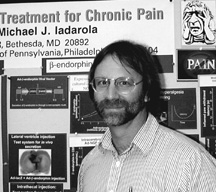
| T H E N I H C A T A L Y S T | M A R C H – A P R I L 1999 |
|
|
|
PAIN, CNS DISORDERSTARGET OF NOVEL GENE THERAPY PATHWAY |
 |
|
Michael
Iadarola tells his research story in Catalyst "Commentary"
|
NIDCR researchers have pioneered a new pathway to ameliorate chronic pain: gene transfer by recombinant adenoviral vector to deliver a b-endorphin gene directly into the meningeal tissues surrounding the spinal cord.
After long trial and error (see "Commentary"), they came up with a magic vector-target combo that induces nonneuronal cells to bathe the cord in analgesic balm.
The minigene is constructed so that the connective tissue cells of the pia mater will secrete b-endorphin into the cord and the cerebrospinal fluid (CSF). The strategy has relevance for neurodegenerative disorders and spinal cord injuries as well. Part of the Clinical Center’s new bench-to-bedside initiative, the research was done in collaboration with the University of Pennsylvania in Philadelphia.
"We are totally pumped up. This approach is working, at least in the animal model," said Michael Iadarola, explaining his poster on "Viral Gene Transfer Approaches to Treatment for Chronic Pain" at the NIH Research Festival. Delivery of the b-endorphin gene into the CSF, he said, resulted in the rat’s failure to exhibit the typical reaction to pain that would have resulted from an inflamed paw.
The brain or spinal cord tissue is not as hospitable a destination as the CSF space, said Iadarola, chief of the Neuronal Gene Expression Unit in the NIDCR Pain and Neurosensory Mechanisms Branch. "If you inject a virus into brain tissue, it doesn’t percolate well through the limited extracellular space in between neurons—and the axonal tracts form a physical barrier against the virus in three-dimensional space—but injection into the CSF will transduce pia mater cells over a broad area," he said. Both the poster and a paper to be published in the May 1 issue of Human Gene Therapy were coauthored by Alan Finegold, previously an NIDCR staff fellow and now in the private sector, and UPenn anesthesiologist Andrew Mannes.
It is possible, Iadarola said, that within a year, this "paracrine paradigm" will be tested in humans, in a collaborative NIDCR-NIAMS clinical trial to alleviate pain in terminal cancer patients and, later, in patients with certain inflammatory joint problems—without the side effects associated with opiates.
"Injecting genes
into nonneuronal cells to bathe the neurons can work for motor as well as sensory
neurons," Iadarola added. "Assuming the disease can be treated with
a secreted gene product, like a protein or a growth factor or a neuropeptide,
you can go the pial-meningeal route or even into the ependymal cells that line
the ventricles or the synovial cells that line the joints. It is not a direct
correction of a genetic defect, but it can provide a paradigm" for Parkinson’s,
multiple sclerosis, spinal cord injury, and many other central nervous system
disorders, he said. It may be especially effective, he added, where large sectors
of the brain are involved, with the viral vector reaching into the deep recesses
of the sulcal spaces after installation into the subarachnoid CSF over the cortex.
![]()